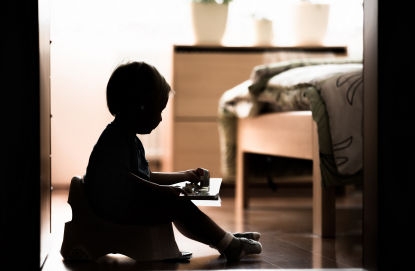Toilet training should start when your child begins showing signs of being ready to use the toilet. This is often around 18 months to 2 years of age, though not always. It’s important to work with your child’s individual developmental pace when it comes to toilet training.
Looking for toilet training tips and tricks? Check out our article on everything you need to know before toilet training your toddler.
Pressure, fear, and stress should be left out of the process. Your child is learning a new skill, so parents should be ready to show patience, support, and encouragement as their little one tries fails and tries again to use the toilet.
Cues that your little one needs to go will likely be familiar to you by now. Signals could include a certain facial expression or sound. Help label what’s happening by asking ‘Do you need to do a poo?’ or saying ‘Looks like you need to wee’. Hearing this language will enable your child to eventually communicate to you when they need to wee or poo.
You will know your child is approaching readiness for toilet training when they display some of the following:
● Pulling pants down and upon their own
● Begin mimicking more of your behavior
● Know how to tell you when they have gone in their nappy, or when they need to go
● Try to get out of their soiled nappy, or ask for it to be changed
● Keep nappies dry for longer stretches of time – indicates the beginning of bladder control
Don’t be shy – weeing and pooing are natural. While your child is learning to use the toilet, celebrate their movements. Teach them not to be ashamed, and to be proud when they start consistently making it to the toilet in time.
There will likely be some false alarms. If your child has been sitting on the toilet for a few minutes with no success, don’t pressure them. Let them know you can try again later, and thank them for trying. Straining to go to the toilet can damage some muscles, so don’t force your child to go if they’re not ready.
A healthy diet full of fiber, fruits, vegetables, grains, and legumes can make stools easier to pass.
Be a team – keep communication open about toilet time and encourage your little one to let you know how their body feels. If they make a mess, keep your cool. This may be frustrating, but your child shouldn’t be punished while they’re learning to control their sphincter muscles.
Weaning off nappies can take a few days, weeks, or months. Start by ditching the nappy during the day, but nappy up for sleep.
After a period of successfully using the toilet at home, you can try going nappy-free outside the home. Try taking your little one out and about without a nappy on a day where you can go straight home should an accident occur. If an accident does happen, support your little one through what might be an embarrassing experience. Bring a change of underwear and clothes, just in case.
Establish hygiene habits as you toilet train. At first, you will need to wipe your little one until they develop the necessary motor skills. Explain to children with vaginas about wiping front to back, and explain to children with penises about shaking when they’ve finished weeing. Always have your little one wash their hands with soap after using the toilet.
Recommended Articles:
https://www.babybunting.com.au/baby-talk-blog/toddlers-and-dinner-time/
https://www.babybunting.com.au/baby-talk-blog/growing-your-toddler-into-a-confident-kid/



